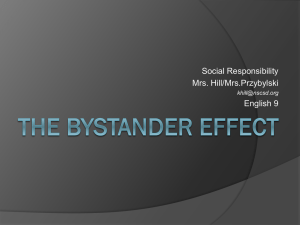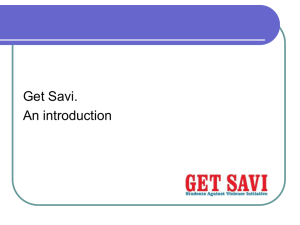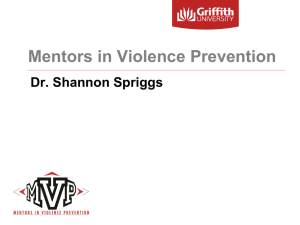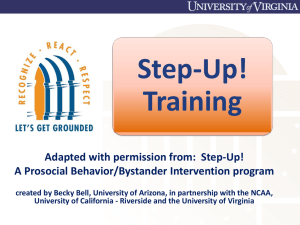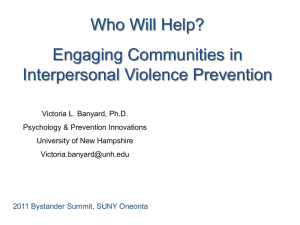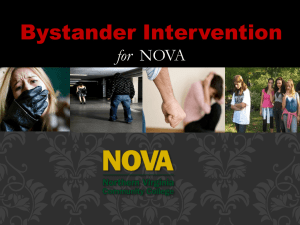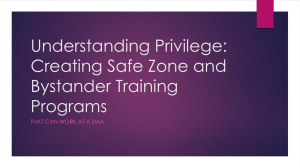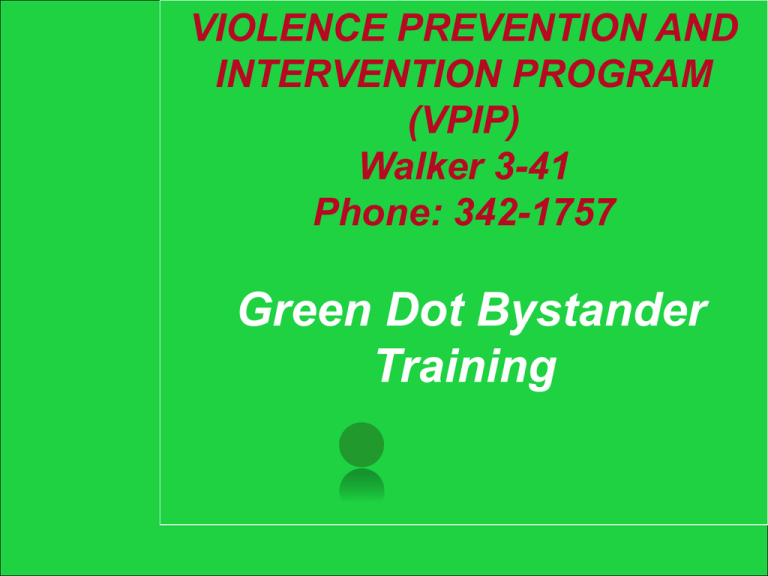
VIOLENCE PREVENTION AND
INTERVENTION PROGRAM
(VPIP)
Walker 3-41
Phone: 342-1757
Green Dot Bystander
Training
Introduction from Presenters
Dr. Pamela Saulsberry
Head, Department of Social Work
Co-Director of VPIP
Dr. Robert Hanser
Head, Department of Criminal Justice
Co-Director of VPIP
I long to accomplish a
great and noble task, but
it is my chief duty to
accomplish humble
tasks as though they
were great and noble.
The world is moved
along, not only by the
mighty shoves of its
heroes, but also by the
aggregate of the tiny
pushes of each honest
worker.
-Helen Keller
GREEN DOT SUMMARY
(See Handouts 1 & 2)
1.
2.
3.
4.
5.
6.
7.
What’s with the Green Dot?
Justification
Scientific Basis
Social Diffusion Theory
Bystander Literature
Branding Research
Application to Violence
Prevention
How much do you believe we can actually,
measurably reduce the number of victims of
power-based personal violence?
1. I am positively
certain
2. I am fairly certain
3. I am doubtful,
but hopeful
4. I don’t think we
can, but we
should try
anyway
Any sexual
contact
that lacks
consent
and/or
capacity
to give
consent.
physical, sexual,
or psychological
harm, or threat
of harm, by a
current or
former partner.
•Enter your own statistics here
course of conduct
targeted at an
individual or
group that would
cause a
reasonable
person to feel
afraid
(following, facebooking,
texting, calling,
unwanted letters, gifts,
etc.)
•Enter your own
statistics here
Have you had an act of power based
personal violence committed against
you?
1. Yes
2. No
Do you know someone who has had
an act of power based personal
violence committed against them?
1. Yes
2. No
If you know someone who has had an act of
power-based personal violence committed
against them, was there ever a bystander
who could have attempted to stop the
violence?
1. Yes
2. No
Have you ever directly
observed a red-dot moment?
1. Yes, on campus
2. Yes, off campus
3. Yes, both on and
off campus
4. no
5 REASONS WE MAY NOT
INTERFERE
Diffusion of Responsibility: More likely to
help if you are by yourself; less likely to
help when more people are around.
5 REASONS WE MAY NOT
INTERFERE
Evaluation Apprehension: Risk of
embarrassment if the situation turns
out to NOT be an emergency.
5 REASONS WE MAY NOT
INTERFERE
Pluralistic Ignorance: If we are not sure
the situation is an emergency, we will
look at others. If they do not act
concerned, we presume there is no
emergency.
5 REASONS WE MAY NOT
INTERFERE
Cause of Misfortune: This is victimblaming. If we believe that the person
being harmed put themselves in the
vulnerable position, we believe that it
is their fault for the misfortune that
happens to them.
5 REASONS WE MAY NOT
INTERFERE
Helping Model: If there is nobody around
to model behaviors of assistance, we
are less likely to know what to do. On
the other hand, if others do so, we are
more likely to aid and assist.
GREEN
DOT
RECOGNIZE
SELF
DEFINING
MOMENT
Understanding Offender Behaviors
that:
1)are potential high risk
2)could be pre-cursors to high risk
✔ Listen as a bystander
✔ Connected to recipient
or offender or both
STRANGERS
Higher levels of gratuitous violence
More likely to use a weapon
Bystander safety is paramount
• Unwanted phone calls (home, work, cell)
• Showing up everywhere
• Using friends or family to get info
• Tracking
• Unwanted gifts
• Monitoring emails, texts, phone calls, etc
• Electronic monitoring (GPS, etc)
Have you ever seen these types of
behaviors exhibited in a way that was
concerning for you or someone you
cared about?
1. Yes
2. No
Stalking Behaviors within a
Relationship
Normal Behaviors within a
Relationship
Texting a zillion times each day
Texting a zillion times each day
Showing up where the person is
Showing up where the person is
Tracking status on Facebook
Tracking status on Facebook
Calling someone all the time
Calling someone all the time
Giving gifts
Giving gifts
Take a second look
Check in
What if it were someone I loved?
Listen as a
bystander
✔ Connected to
recipient or offender
or both
As a bystander, look for:
PHYSICAL ABUSE
•Shoving
•Punching
•Slapping
•Pinching
•Hitting
•Kicking
•Hair pulling
•Strangling
•Restraining
As a bystander, look for:
SEXUAL ABUSE
•Unwanted touching or
kissing
•Forcing to have sex
•Not allowing birth
control
•Forcing to do other
sexual things
Have you ever seen these types of
behaviors exhibited from someone dating
someone you knew or cared about?
1. Yes
2. No
Partner Violence Behaviors
Normal Behaviors within a
Relationship
Feeling jealous and possessive
Feeling jealous and possessive
Wanting to be with the
person all the time
Wanting to be with the
person all the time
Spending less time
with friends and family
Spending less time
with friends and family
Checking in frequently to see where
partner is
Checking in frequently to see where
partner is
Take a second look
Check in
What if it were someone I loved?
✔ Listen as a bystander
✔ Connected to recipient
or offender or both
• Target Selection
younger, drunk, easily controlled
• Approach and Evaluation builds trust, “nice guy,” fills drink, tests
• Separation
questions, isolates from friends, guilt
• Consenting or Pressured Sex
aggressive, guilt, manipulative
Concerning Behaviors that could
lead to Sexual Assault
Normal Behaviors within a
Consensual Hookup
Identifies someone they think they can Identifies someone they think they can
score with
score with
Turns on the charm and tries to get
the person to like them
Turns on the charm and tries to get
the person to like them
Buys the person a few drinks
Buys the person a few drinks
Uses some cheesy line like, “your
place or mine?”
Uses some cheesy line like, “your
place or mine?”
They have sex
They have sex
• Intimidation
increased aggression, force, no longer “nice guy”
• Sexual Violation
aggression, self absorbed
• Termination
ensure no consequences, “nice guy,” blame, threaten
Termination
Alcohol…offenders best friend
• Ability to resist is reduced
• Less likely to report
• Moves blame from offender to victim
Concerning Behaviors that could
lead to Sexual Assault
Normal Behaviors within a
Consensual Hookup
Identifies someone they think they can Identifies someone they think they can
score with
score with
Turns on the charm and tries to get
the person to like them
Turns on the charm and tries to get
the person to like them
Buys the person a few drinks
Buys the person a few drinks
Uses some cheesy line like, “your
place or mine?”
Uses some cheesy line like, “your
place or mine?”
They have sex
They have sex
Take a second look
Check in
What if it were someone I loved?
Have you ever been in a situation (PBPV or not)
when you needed a bystander to help, but they
did not?
1. Yes
2. No
“The important
thing is this: To
be able at any
moment to
sacrifice what we
are for what we
could become.”
- Charles DeBois
Bystander Dynamics
Peer Influence
Personal
Bystander Dynamics
Bystander Dynamics
•Diffusion of Responsibility
•Evaluation Apprehension
•Pluralistic Ignorance
•Cause of Misfortune
•Helping Model
Bystander Dynamics
Peer Influence
Personal
“To go against the
dominant thinking of
your friends, of most
of the people you
see everyday, is
perhaps the most
difficult act of
heroism you can
perform.
- Theodore H. White
Bystander Dynamics
Peer Influence
Personal
•“I’m an introvert”
•“I can’t stand conflict”
•“I’m shy”
•“I hate calling attention to
myself”
•“It’s not my concern”
•“I don’t want to get involved”
You gain strength,
courage, and confidence
by every experience in
which you really stop to
look fear in the face. You
must do the thing which
you think you cannot do.
-Eleanor Roosevelt
Which of these bystander obstacles
might keep you from acting?
1.
2.
3.
4.
5.
6.
7.
There are other people around
who will probably act so I don’t
have to.
Don’t want to be embarrassed
No one else is doing anything
The victim looks like they “had
it coming.”
My friends would give me a
hard time if I did anything
My personality traits make it
hard (I’m shy, hate conflict,
etc.)
It’s not my concern and I don’t
want to get involved.
3 categories of
green dots:
•Direct
•Distract
•Delegate
Who we are is what we do…
It is common sense to
take a method and try
it. If it fails, admit it
frankly and try
another. But above all,
try something.
-Franklin D. Roosevelt
•Closer to situation
•Fewer people around
•More imminent the violence
To sin by
silence when
they should
protest makes
cowards of (us
all).
-Abraham Lincoln
Violence will not be
tolerated
Everyone is
expected to do their
“No one
has to do
everything,
but
everyone
has to do
something”
PART TWO
APPLICATION EXERCISES
Scenario 1 play
DO PAGES 8 – 11
IN HANDBOOK.
(Assign to Groups)
Scenario 1 play
GROUP EXERCISE 1: You are at a party and you see a
girl who is obviously intoxicated, being pulled up the stairs
toward the designated room. Given your obstacles, what
are you most likely to do?
1. Distract: Go to the guy and tell
him you have had too much to
drink and are about to puke
and that he needs to take you
to the bathroom.
2. Direct: Go up to the guy and
ask him what he is doing.
3. Direct: Go up to the girl and
tell her you want to talk to her
in private.
4. Delegate: Tell the girl’s friend
and suggest that she go get
her
GROUP EXERCISE 2: You and your date are at the movies. As
you are moving up the line at the concession area, you see a
couple arguing loudly. One of them is grabbing the other
firmly by the arm and starts yelling at them through gritted
teeth. Given your obstacles, what are you most likely to do?
1.
2.
3.
4.
Distraction: Talk loudly on your
cell phone near the couple while
looking in the direction of the
couple.
Direct: Tell the person to let go
of their partner’s arm and that
they need to cool off for a
minute.
Direct: Check in with the person
whose arm is being grabbed
and ask if they are ok.
Delegate: Tell the guy behind
the register at the concession
area to find security.
GROUP EXERCISE 3:
You notice someone slipping a drug into
someone’s drink at a bar. Given your
obstacles, what are you most likely to do?
1. Direct: You confront the person
who slipped the drug, “I saw you
do that, and I’m going to call the
cops.”
2. Direct: You tell the person whose
drink was drugged.
3. Distract: You “accidently” spill the
drink.
4. Delegate: You let the bartender
know what you saw and ask
him/her to do something
GROUP EXERCISE 4: You are walking into your
dorm/apartment and you see a couple you know standing
nearby. One of them is becoming increasingly angry and
aggressive toward the other. Given your obstacles, what
are you most likely to do?
1. Direct: Approach them
and explain to the
aggressor that what
s/he is doing is not
appropriate and you will
call the police if they
don’t stop.
2. Delegate: Get a few
friends to go out and
see what’s up.
3. Distract: Approach
them and strike up a
conversation.
REVIEW PAGES 18 – 22
IN HANDBOOK.
(Read with Groups and
Discuss)
Scenario 1 play
DO EXERCISES
IN PAGES 23 – 27
OF HANDBOOK.
(Assign to Groups)
Scenario 1 play
YOU HAVE FINISHED BOTH THE CONTENT AND
APPLICATION BASED COMPONENTS OF THIS
TRAINING.
CONGRATULATIONS!
Now, what is next?

